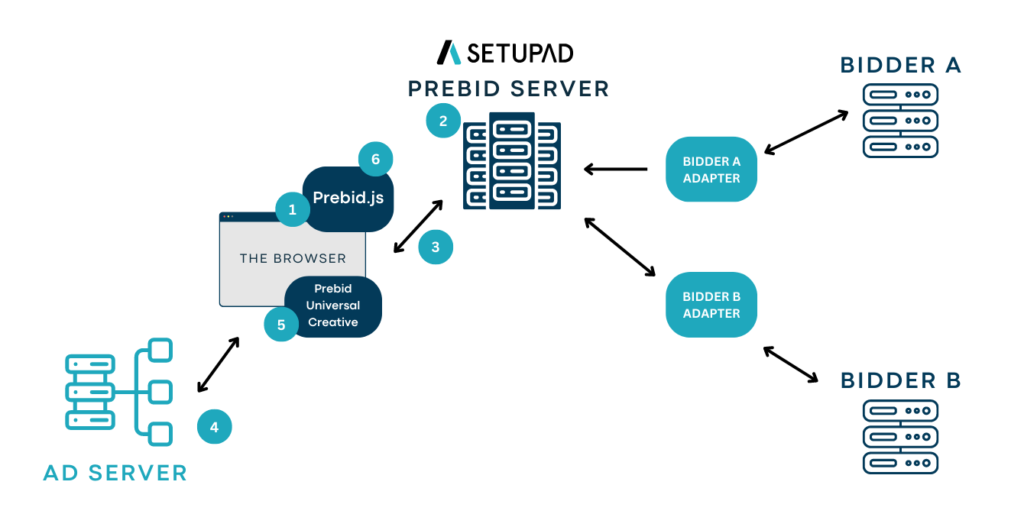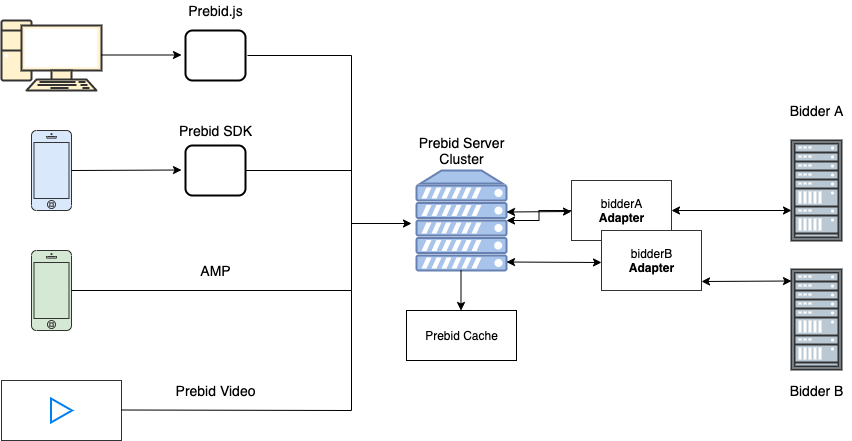¿Qué es Prebid Server?
La comunidad de Prebid.org sigue creciendo, y los años de trabajo están dando sus frutos. AppNexus diseñó Prebid.js en 2015 y, a día de hoy, es uno de los wrappers de header bidding más populares.
Header bidding es una tecnología clave que los editores y socios tecnológicos que utilizan inventario web han incorporado con éxito a su estrategia de monetización.
Prebid Server puede servir como un complemento para Prebid.js o como sustituto, allí donde este último no pueda implementarse.
En este artículo aprenderás qué es Prebid Server, cómo funciona y qué ventajas puede aportar a tu estrategia de header bidding.
¿Qué es un Prebid Server?
El prebid server permite a los editores trasladar las solicitudes de puja de client-side a server-side. Funciona como un proxy para las solicitudes de puja de Prebid.js o Prebid Mobile, o como solución independiente para AMP (Accelerated Mobile Pages).
Para muchos editores, la experiencia de usuario mejoró significativamente con el enfoque de server-side, ya que eliminó los problemas de latencia y mejoró la velocidad de carga del sitio web.
Hoy en día, muchos de ellos utilizan un sistema híbrido de header bidding que combina prebid.js y Prebid Server, y que permite llamar a múltiples socios de demanda, reducir las solicitudes del navegador y mejorar los ingresos generales por publicidad.
Diferencias entre Prebid.js y Prebid Server
Prebid.js es un header bidding wrapper de código abierto que permite a múltiples socios de demanda publicitaria (SSPs y Ad exchanges) pujar al mismo tiempo por el inventario de un editor.
Existen dos tipos de header bidding: Client-side y server-side. Con el header biddingclient-side, la subasta se ejecuta en los navegadores de los usuarios, desde donde se envían muchas solicitudes de anuncios a cada socio de demanda por separado.
En el caso del header bidding server-side, se realiza una llamada a Prebid Server y varias llamadas desde allí a los socios de demanda.
A diferencia de Prebid.js, Prebid Server es un servidor y requiere una ubicación escalable, distribuida y rápida para funcionar.
Prebid.js te permite realizar subastas en el header de tu sitio web:
- se hace una llamada publicitaria a cada postor;
- las ofertas se envían a Prebid.js;
- el ganador se decide en el header.
Por otro lado, al incorporar Prebid Server a Prebid.js, se utilizará Prebid.js implementado en el header de tu web:
- Prebid.js hace una llamada publicitaria a Prebid Server;
- A continuación, Prebid Server envía solicitudes de puja a todos los postores;
- Los postores envían sus ofertas a Prebid Server;
- Éste devuelve todas las pujas a Prebid.js y la subasta tiene lugar en el header.
En resumen, la decisión se reduce básicamente a cómo quieres aumentar la demanda y mejorar la experiencia de usuario.
Puedes añadir tantos SSPs como desees con la ayuda de un prebid server sin preocuparte por ralentizar o interferir en la experiencia de usuario mientras los anuncios se cargan en la página.
Además, a diferencia de la configuración de client-side de Prebid.js, con la configuración server-side, solo es necesario realizar una solicitud.
Sin embargo, Prebid.js es bastante más sencillo y rápido de configurar para aquellos editores que carecen de la capacidad de ejecutar su propia solución de servidor.
En cualquier caso, se necesita Prebid.js tanto si se utiliza Prebid Server, como si no.
Además, el lado del cliente puede ofrecer mejores oportunidades de ingresos debido a una mayor tasa de coincidencia de cookies.
Conexiones clien-side frente a conexiones server-side
La mayoría de editores y empresas de monetización utilizan header bidding client-side. En esta configuración, la subasta de header bidding en tiempo real tiene lugar en el navegador web del usuario, como por ejemplo, en Google Chrome.
En cambio, con header bidding server-side, el usuario envía una única solicitud al servidor, que a su vez realiza varias solicitudes a los SSPs y Ad exchanges.
Al no intervenir el navegador del usuario, los postores responden más rápido.
Para los vendedores es más fácil ejecutar header bidding client-side en todos los formatos, gracias a las inversiones que han realizado varios proveedores importantes en las soluciones que integran prebid server con su tecnología, al tiempo que conservan las ventajas de un wrapper de código abierto.
Prebid Server en el concepto de header bidding
La transparencia, la flexibilidad y la innovación que impulsa la comunidad ha mejorado el head bidding. El header bidding de Prebid es una mejor forma de monetización que la metodología en waterfall para generar ingresos publicitarios.
A pesar de ser una alternativa preferible, Prebid.js no cuenta con las características necesarias para soportar anuncios en aplicaciones móviles y sitios AMP.
Que no cunda el pánico: para eso tenemos Prebid Server.
Header bidding es una tecnología compleja que no es fácil de manejar para los editores, pero Prebid Server les permite utilizarla sin problemas en sus aplicaciones de Android e iOS.
Además, reduce la latencia del proceso de header bidding al permitir pujas simultáneas por parte de los diferentes interesados en el inventario del editor.
Setupad ofrece una solución de header bidding: una solución directa de Prebid.js que se conecta a las cuentas SSPs de un editor y permite la optimización entre las ventas programáticas y directas.
Las conexiones server-to-server (S2S) de Setupad permiten a los editores obtener una mayor demanda y generar ingresos publicitarios adicionales sin que la velocidad del sitio web se vea afectada.
¿Cómo funciona Prebid Server?
Prebid Server funciona como un complemento de prebid.js, y permite trasladar las solicitudes de puja del lado del cliente al lado del servidor.
A continuación, se muestra cómo funciona:
- Prebid.js se configura con el código “s2sConfig“, para gestionar subastas para uno o más postores.
- La subasta se produce una vez que Prebid Server analiza la solicitud.
- El navegador recibe la respuesta con todas las creatividades junto con el cuerpo de la creatividad ganadora.
- Para apps, vídeo y AMP, Prebid Server devuelve un enlace a la caché de Prebid, donde se almacena el código de la creatividad.
- Prebid.js pasa las variables de segmentación del servidor de anuncios a la página, que la reenvía al servidor de anuncios.
- El servidor de anuncios responde a la página con la creatividad universal de Prebid cuando un anuncio gana el header bidding.
- Esto le indica a Prebid.js que utilice su función render para mostrar la creatividad.

El socio que realiza la puja más alta se encarga de publicar los anuncios en el espacio publicitario del sitio web. Es importante tener en cuenta que Prebid Server no determina el ganador final de la subasta; de eso se encarga el servidor de anuncios.
Sin embargo, Prebid Server toma dos decisiones que afectan a las ofertas que se envían al servidor de anuncios:
- La mejor oferta de cada postor para cada impresión o visualización: Prebid Server devuelve una oferta de cada postor para cada objeto de impresión. El cliente puede recibir varias ofertas del mismo postor si la solicitud admite ofertas múltiples.
- ¿Qué postor recibe los valores de segmentación para hb_pb, hb_size y hb_bidder para cada objeto de impresión?: Esta acción solo se lleva a cabo cuando se proporciona ext.prebid.targeting. Aunque esto es más importante para AMP, otros clientes (por ejemplo, apps) podrían confiar en Prebid Server para seleccionar la oferta «ganadora».
Las fases de funcionamiento fundamentales de Prebid Server son:
- Prebid server verifica y completa las solicitudes entrantes, resuelve las solicitudes dinámicas almacenadas (solo se aplica a AMP y apps), y hace que se cumplan las normas de privacidad. El servidor verifica y completa las solicitudes entrantes: resuelve solicitudes dinámicas almacenadas (se aplica solo para AMP y aplicaciones) y hace cumplir las regulaciones de privacidad.
- A continuación, prebid server llama a los bid adapters de server-side.
- Una vez que todos los postores han respondido (o si ha expirado el tiempo de espera), prebid server genera una respuesta válida: se encarga de la conversión de divisas, cuantifica las pujas y almacena en caché los XML o o creatividades de El servidor de oferta previa genera una respuesta válida: el servidor de oferta previa se encarga de la conversión de moneda, cuantifica las ofertas y almacena en caché. VAST.
Además del servidor de preofertas, la caché de preofertas admite casos de uso para AMP y vídeo almacenando VAST y ofertas según sea necesario. La caché Pebid almacena el código creativo devuelto por la puja, que puede ser tanto código creativo VAST como simple código de anuncio de display.

Fuente: Prebid
¿Qué ventajas tienen prebid server?
Estas son las 5 principales ventajas de Prebid Server:
- Más transparencia.
- Soporte analítico opcional.
- Subastas simultáneas.
- Varios socios.
- Reducción de la latencia de las páginas.
En Prebid SDK no existe el concepto de cookies, por lo que no se produce sincronización en ese escenario, y el ID en móviles se basa en el IDFA (identificador para anunciantes).
Además, a medida que se eliminen las cookies, Prebid Server ya no necesitará una capa separ
Ejecutar un Prebid server: Solución alojada vs Solución personalizada
Prebid Server ha simplificado el proceso de forma drástica, pero utilizar header bidding sigue siendo un reto, pues es posible que se necesite la ayuda de un equipo de AdOps y tiempo adicional para formalizar los contratos con los postores.
Por tanto, implementar header bidding de forma independiente con un prebid server puede ser caro para los editores y, por este motivo, hay ocasiones en las que tiene sentido optar por soluciones que ya hayan optimizado todos los procesos.
Asociarse con un proveedor de servidores prebid como Setupad es la forma más rápida y rentable de adquirir capacidad de servidor prebid.
Un inconveniente es que no puedes controlar el código que te proporciona un proveedor externo y, si otro servicio gestiona tu experiencia de header bidding, podría aumentar la latencia de la página en tu sitio web, en función de cómo esté configurado.
Al final, si quieres utilizar tu propio perbid server, necesitas disponer del tiempo (puede llevar años) y de los recursos necesarios. Sin embargo, una solución gestionada se encarga de todo.

El inconveniente de Prebid
Para algunos vendedores, el atributo más valioso de Prebid, el código abierto, es un inconveniente. Este diseño hace que Prebid sea transparente, por lo que los editores deben tomar la iniciativa o buscarse un socio técnico experto.
Como los editores carecen de los conocimientos necesarios para gestionar prebid, varios optaron por wrappers específicos, que también tienen desventajas, pues las diferencias en los métodos de recuento y pago dificultan las transacciones entre compradores y vendedores.
Además, algunos wrappers impiden la participación de determinados tipos de demanda, a no ser que los equipos internos hayan actualizado o creado adaptadores de terceros para integrarlos en la subasta.
En general, los editores suelen utilizar distintas soluciones de header bidding a la vez, por ejemplo, Prebid y Google Open Bidding).
De esta manera, las DSP reciben las impresiones de cada SSP multiplicadas por los wrappers o capas de software, lo que ha provocado su descontento y les ha llevado a exigir que los SSPs y los editores escojan un único formato de wrapper.
Las normas del sector cambian y se espera que la mayoría de los editores elijan Prebid como wrapper principal.
¿Cómo empezar con Prebid Server?
Hay 3 requisitos para empezar a utilizar Prebid Server:
- Necesitas un servidor para alojar Prebid Server. Los editores deben contar con un servidor para alojar prebid server y, para eso, pueden trabajar con socios que dispongan de uno, como Setupad, o crear su propio servidor.
- Necesitas instalar o actualizar la configuración de Prebid.js. Los usuarios de Prebid.js deben actualizar sus versiones con el código de prebid server. Los editores que no dispongan de un adaptador para Prebid Server deben descargar el archivo prebid.js con Prebid Server activado.
- Necesitas incorporar adaptadores. Las configuraciones de las subastas y del adaptador son importantes. Los editores que ya utilizan Prebid.js pueden solicitar que sus equipos actuales habiliten la configuración del lado del servidor.
Conclusión
Prebid ofrece un grupo de productos de header bidding de código abierto gestionados por toda una comunidad a nivel mundial. Por este motivo, es bastante asequible y atrae a cuantos participan de la tecnología publicitaria.
Teniendo en cuenta que, como editor, deseas concentrarte en la creación de contenidos y ahorrar recursos, muchas soluciones gestionadas te ofrecen la implementación de Prebid. La solución Setupad Prebid es una opción completa y eficaz para que los editores maximicen sus ingresos publicitarios a la vez que optimizan las campañas directas con socios de demanda programática.
Esta tecnología está preconfigurada, se proporcionan adaptadores para conectar con las cuentas de GAM y SSPs de los editores y los ingresos publicitarios se pagan directamente al editor a través de los socios de demanda. Todas las campañas y ofertas programáticas compiten en la misma subasta de header bidding, lo que aumenta los ingresos publicitarios de los editores.
Esta terapia, además wrapper de header bidding de Setupad se ha creado con Prebid.js y está optimizado para integrarse sin problemas en el código fuente de un sitio web o en el servidor de anuncios del editor. Esta solución basada en Tags recoge las ofertas de las conexiones client-side y server side para mostrar los anuncios programáticos ganadores.
En cualquier caso, si decides gestionar prebid de forma independiente, asegúrate de que tu equipo está capacitado para hacerlo.


